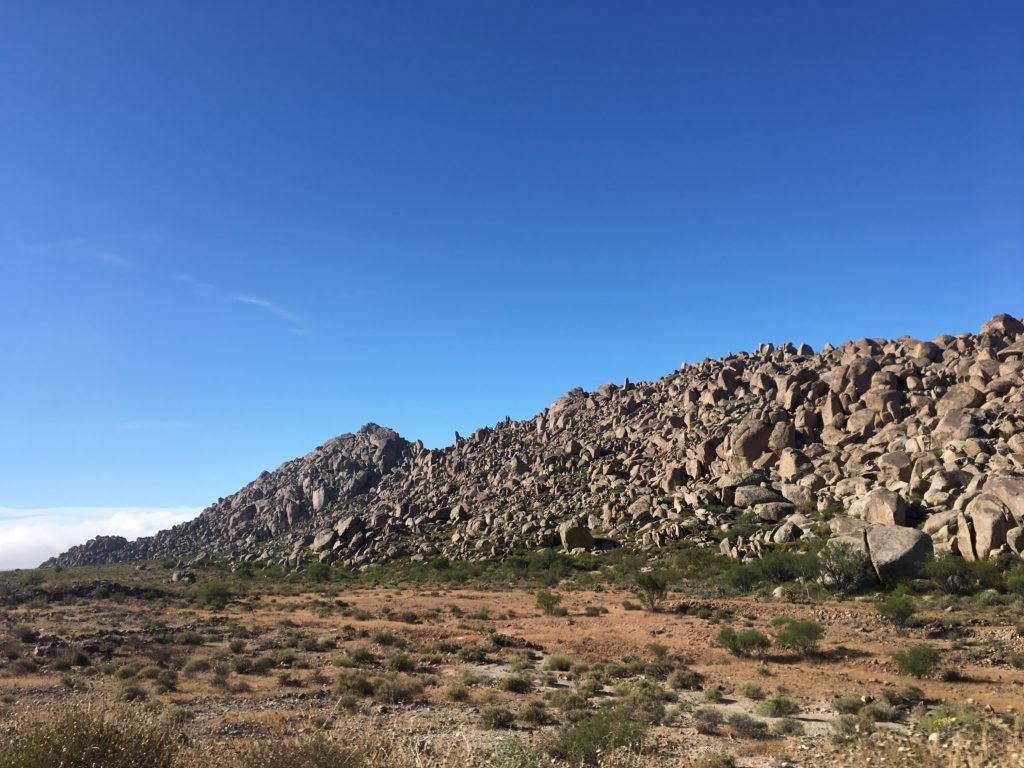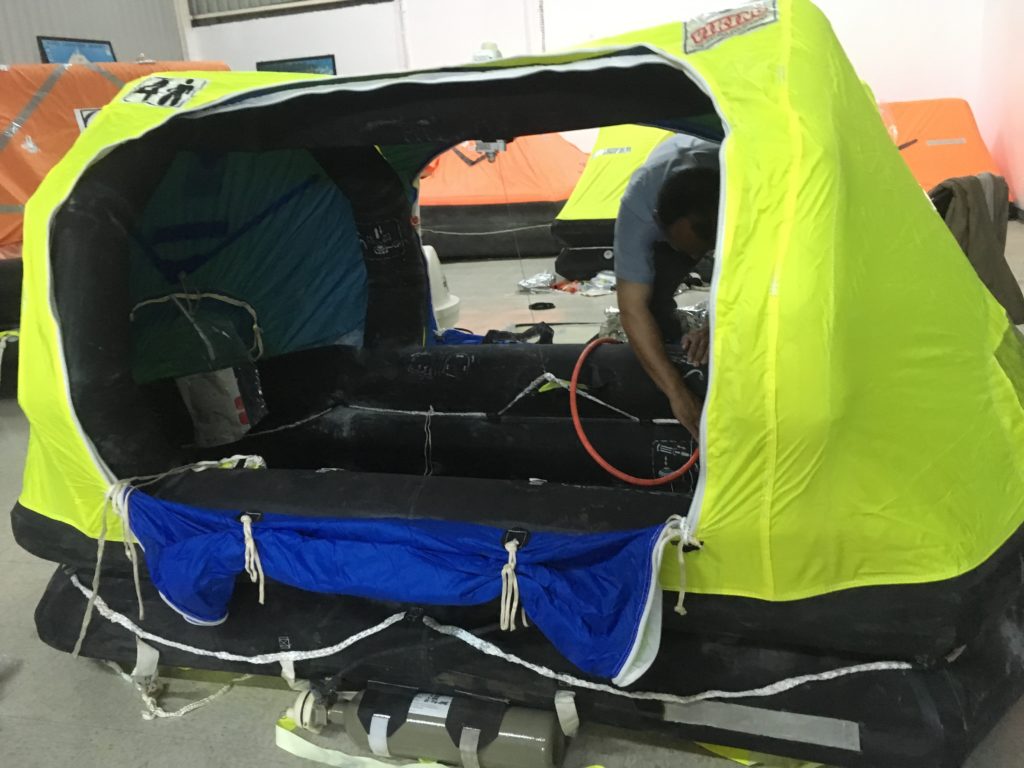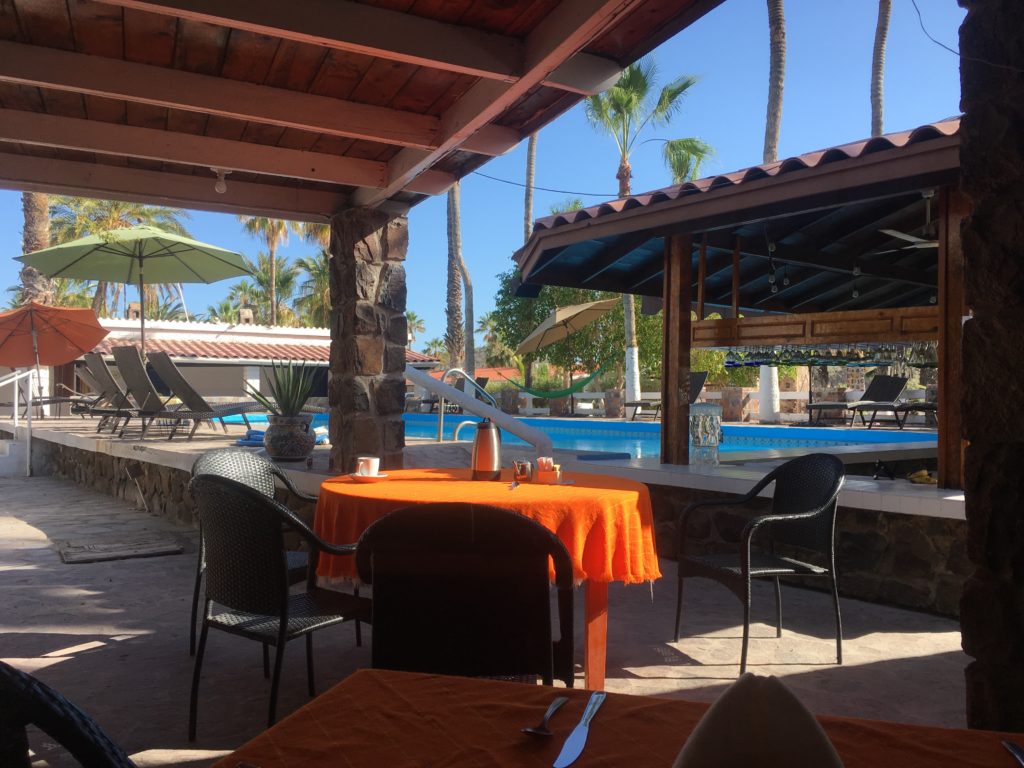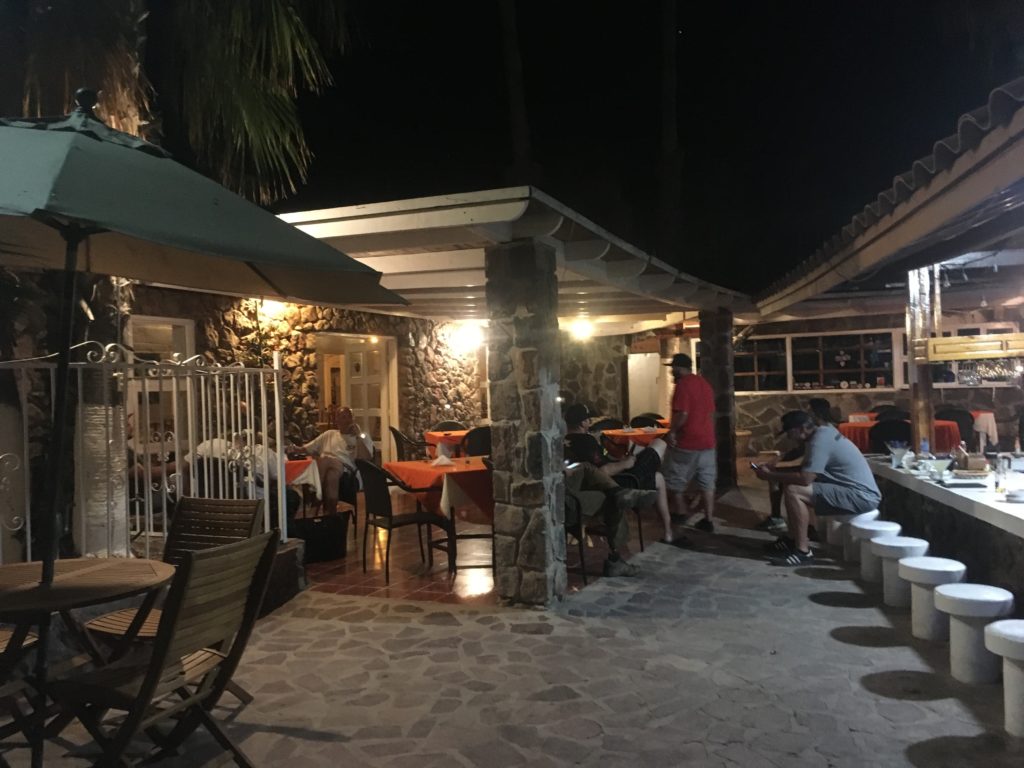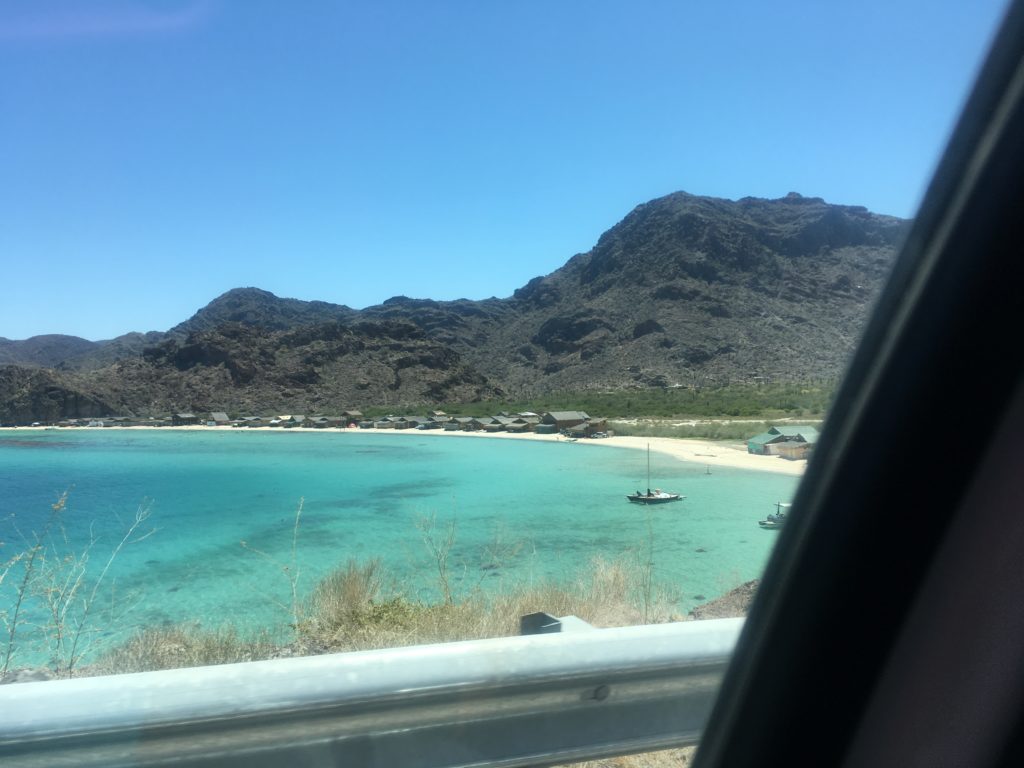In preparation for sailing across the Pacific to French Polynesia next spring, we needed to recertify our liferaft. The closest place to do that is Ensenada, over 1,000 kilometers north of La Paz, where Cool Change is now. Since we probably couldn’t fly with a self-inflating liferaft, we had to drive. We decided to take advantage of the road trip to pick up some things in San Diego that would also be difficult to carry on a plane, like a new water heater, a wind generator, and an inflatable kayak, amongst many other goodies.
We were able to rent a car for $5 US per day. Well, sort of. We declined the collision insurance of an extra $40 per day based on our use of a credit card that provides collision insurance, but we think maybe Rentalcars.com might be charging us $17 US/day as some type of penalty they call “legal insurance” for failing to buy collision insurance. And then an extra driver is costing $4/day. So, all in all, the daily charge could be as much as $26 US per day, which still isn’t bad. The one and only trans-peninsular road in Baja is rough on cars, so we are glad we aren’t using our own US car for this trip.
As the trip planning became more and more complicated, with the coordination of changing cars at the border so we could cross, picking up our packages from our friend Susanne near San Diego, and planning for distances and driving times to drive in the daylight only, I was concerned that we might forget something. Most importantly, I was afraid we would forget the very reason we decided to do this trip in the first place: the liferaft. So as usual, I made abundant lists. However, at one point, the list of what to bring with us when we left La Paz got so long and scribbled that I rewrote it, and when I did, I left something off by mistake: the EPIRB. An EPIRB is an emergency beacon that notifies the coast guard when you abandon ship, and it has a battery that has to be replaced every so often. There are very few places in Mexico that are certified to change this battery, which costs about $300 US. So we found a place in San Diego to change it out, and we partially planned our San Diego trip around getting that battery replaced. About halfway up the Baja Peninsula, it dawned on us that we had forgotten the EPIRB. Now having lost our one opportunity to carry it across the border by land, I just hope when we return to the States this summer that we can talk Homeland Security into letting us fly on the plane with it!
The first day’s drive up the state of Baja California Sur went surprisingly smoothly. There were three military checkpoints, but in only one did they make us get out of the car to lightly search, and of course, we had nothing they wanted: no guns and no drugs. They didn’t check our ID’s and only wanted to know our origin, destination and purpose of our trip. “Vacation” seemed to be the answer they were looking for, so we gave it to them. There were a few long, dusty dirt road detours on the highway, but otherwise, the highway in Baja California Sur was in excellent shape.
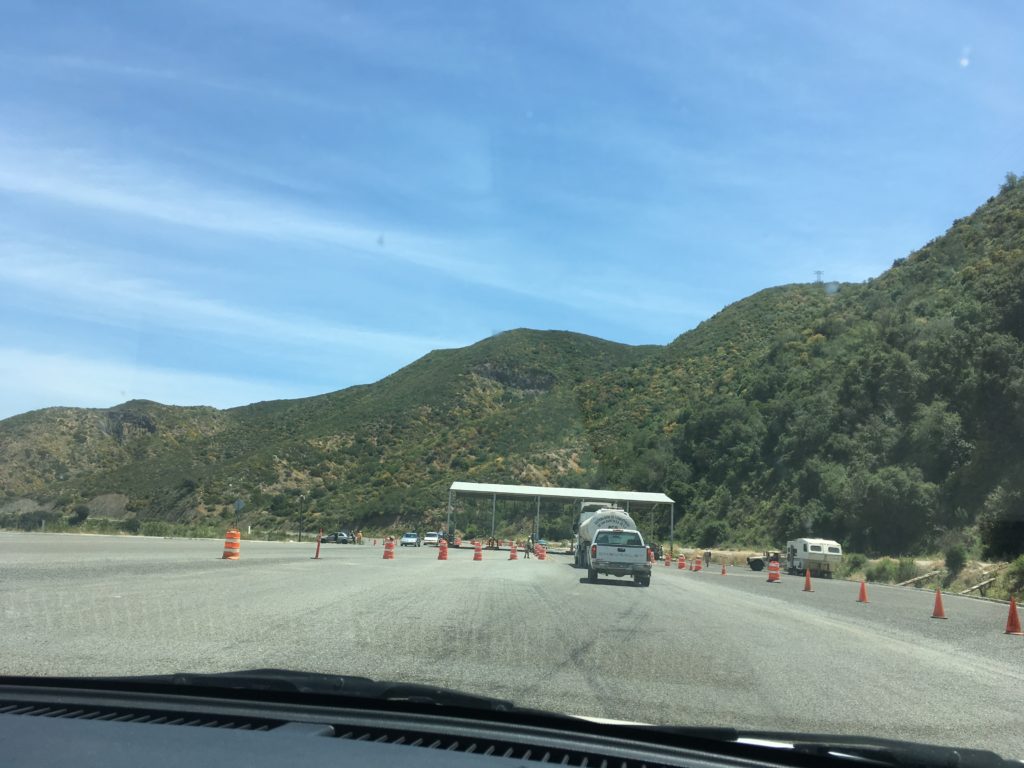
Military checkpoint – there were several on our trip but they were usually not a problem. Only one of 12 we passed through asked us to get out of the car so they could search, and that was on our way north out of La Paz.
Leaving about 9:00 am from La Paz, we made it to Guerrero Negro before dark. There are so few towns with hotels along this route that you really have to plan ahead where you are going to stop for the night, especially since driving in the dark can be dangerous due to unseen obstacles and wild truck drivers on narrow roads with no shoulders. We checked out a number of hotels in Guerrero Negro, some of which either weren’t where they were supposed to be or no one answered the door, before we settled on a clean room with a hot shower and off-road parking for $25 US called the Cowboy Hotel.
Although the origin of the name ‘black warrior’ must have a good story behind it, there is really not much to see in Guerrero Negro. It’s location along the west coast of the Baja Peninsula just before the highway crosses the peninsula to the east coast, makes it a fairly popular town for most necessary services. It is also the only service center for hundreds of kilometers in either direction. It’s claim to fame for tourists is whale watching in the late winter/early spring, but we missed that by a few months. As a result, few restaurants were open, so we settled on the restaurant within our hotel. It was big but mostly appeared to cater to carry out. I had the chicken fajitas, which was a big portion and tasty except that there was no hint of traditional fajita seasoning, not that there is anything traditionally Mexican about fajitas anyway – it is a gringo invention. Rick couldn’t resist the baked potato, advertised as having everything but the kitchen sink stuffed inside it, including cheese, vegetables and even chunks of meat. Well, one look at it and he was sick as a dog, all night long. I mean, violently retching all. night. long. I should have insisted that he go right to the hospital but he refused, concerned about our schedule. We found the grocery store in town and I bought gator aide and water and bananas to help restore his tummy, and we took off again.
Passing through the desert north of Guerrero Negro was the first time I understood that a desert can be beautiful. This whole section of the peninsula is a biopreseve, like a national park, and I could see why. Maybe it was just the heavy rains we had this year, but the desert was lush with more color than I had ever seen: yellow and red covered the landscape like a vail. And this particular section of desert was not flat; instead, it was really bumpy, like some giant moles had dug it up everywhere, between the various sizes of boulders that also made the landscape as uninviting to walk across as it was magnificent in its complexity. And lots of those large, treelike cacti decorated the uneven landscape; they looked a lot like the Saguaro cactus. And then we got into this section where it was flat, except as if emerging out of nowhere, these huge mountains of boulders appeared. Your first thought is that they could have been moved there as part of the construction of the highway, except then you saw that they went on and on and were huge – way more than you could dig up. Apparently, they are naturally occurring like that.
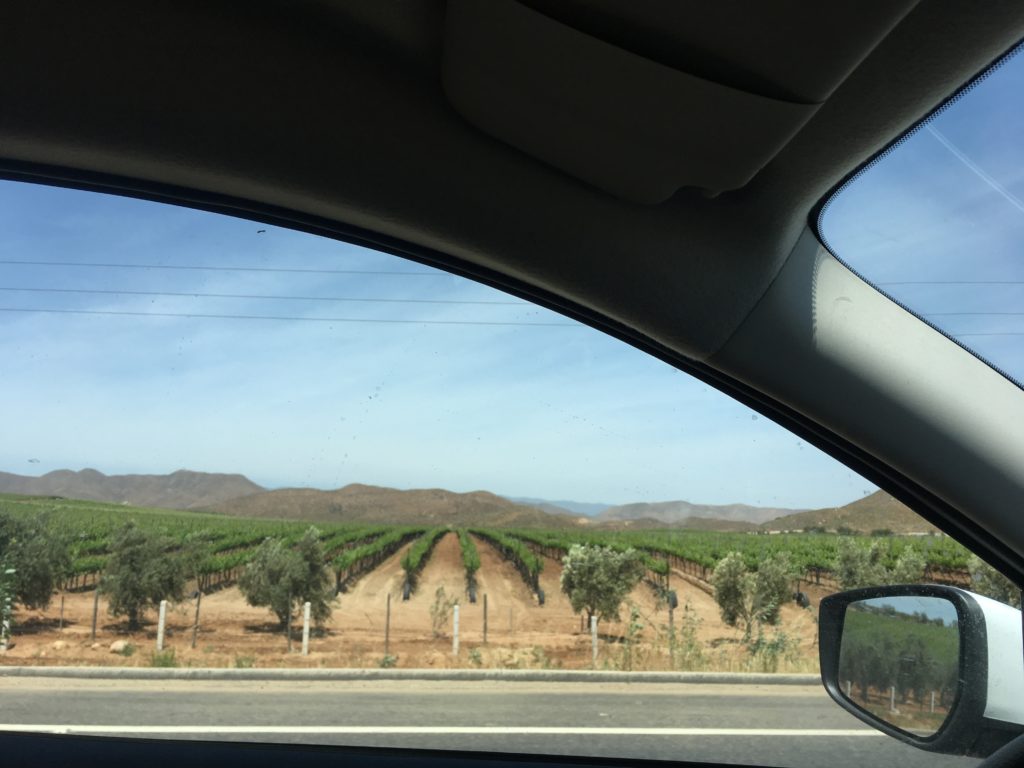
Northern Baja California is known as wine country. The road to Ensenada is known as the ‘ancient wine route,’ as opposed the the modern wine route from Tecate to Ensenada. We saw a few of the more established, large wineries along the ancient route.
By the second night, we made it to Ensenada and stayed at Hotel Cortez with guarded parking in the center of town. It had a semi-inviting pool except that it was full of children. I asked for a quiet room, but even it could not muffle the noise of families on vacation. Rick still couldn’t eat but at least he wasn’t still vomiting spontaneously. I ordered room service for myself, which tasted fine.
The next morning, we took our liferaft to Arturo of S.O.S., the only person certified on the west coast of Mexico to recertify our liferaft, and watched him carefully unpack a perfectly well-packed-at-the-factory liferaft to get to the expired contents (drinking water, flares, flashlights, etc.) inside and replace them. While he was at it, he inflated the liferaft, which seemed fine otherwise.

Arturo from S.O.S. opening the factory-closed liferaft for the first time. It was painful watching him, as we know he was going to have to close it back up just as it was at great expense to us, but we just couldn’t imagine crossing the Pacific with an expired liferaft.
From Ensenada, we drove the hour and a half to the Tijuana airport, exchanged our car at the Dollar office for a car with license plates that allowed us to cross the border, and took the Otay border crossing in the “Ready” lane into the US with no waiting whatsoever. The “Ready” lane, for those who don’t know like I didn’t, accepts US citizens with valid passports. I was panicked we had accidentally gotten into the wrong lane after reading about people who were fined for trying to drive through the wrong lane before. But as I went to explain to the officer in Spanish how we had accidentally gotten into this lane, he stopped me and first asked, “why are you speaking Spanish?” and then reassured us that we were now in “friendly territory” and that we were indeed in the correct lane. The lane right next to us, the one for people that weren’t US citizens, I gather, was bumper to bumper for a long ways back.
We arrived in the US the same morning we left Ensenada. I couldn’t believe it. I had hoped we would get there before dark, and instead, we had the whole day to enjoy. We had planned all our shopping errands (about five stores) for Tuesday morning, and now it looked like we could get most of them done Monday. The big shopping, of course, was to be done as West Marine in San Diego, where we spent a good part of the afternoon. But then as we were starting to look for a hotel, Rick announced that his stomach was taking a turn for the worse. He was convinced he needed antibiotics, now! We tried to reach Rick’s brother, a doctor, so he could call in a prescription locally, but to no avail. As Rick was about to concede to just wait till we got back into Mexico to deal with getting drugs more easily and cheaply, we were able to find an urgent care center nearby. That was a three hour ordeal, but he walked away with a prescription, which took us another three hours to get filled.
Meanwhile, Rick still wasn’t feeling hungry, but he looked forward nevertheless to the walk from the Old Town Hotel to the center of the Old Town San Diego neighborhood several blocks away. We didn’t get started until well after dark due to the delay in filling the prescription, but Rick was able to find a highly recommended sushi restaurant for me that was open late. I finally got to have a nice glass of California Chardonnay, and the food was excellent. Rick ate his share, feeling emboldened by his first dose of a strong antibiotic.
The next morning, we finished our shopping, picked up our packages from Susanne, took Susanne and her mom out for lunch for Thai in Imperial Beach, crossed back through the Otay border, got the “green light” at the border so drove right through without even having our passports checked, exchanged our car at Dollar back to the Mexican car, got right back on the excellently-maintained tollway to Ensenada, found a lovely, large cabin with deck on the ocean north of Ensenada, and were sipping a California Zinfandel on the deck by sunset.

Enjoying California wine on our private cabin deck in Ensenada after thinking we had finally completed our “to do” list for this trip and could now relax.
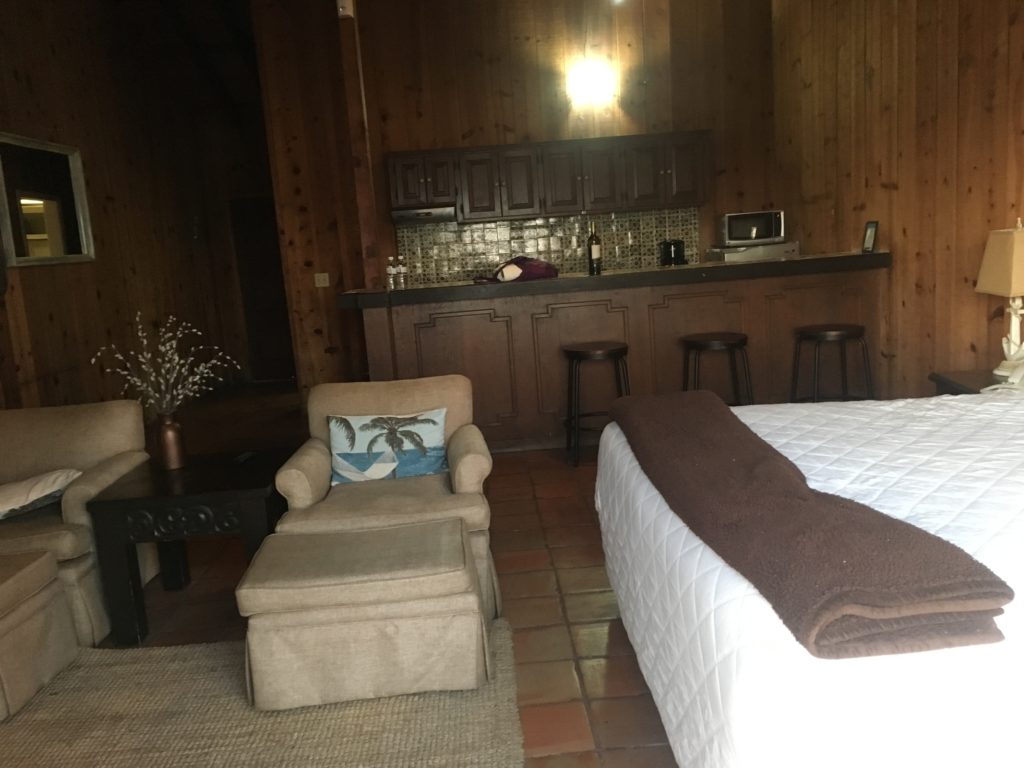
A large cabin with tall
ceilings, a kitchen, a king-sized bed, a sitting area with two comfy chairs, and a clean but 1947-era bathroom was a treat for us after all our chores were done. Or so we thought.
Apart from forgetting the EPIRB and Rick’s bout with food poisoning, which was now well on the mend, I couldn’t believe our luck so far on this trip. Everything had gone so smoothly: the driving had been long but doable, the border crossings had been a cinch, the airport car exchange was efficient and easy, and the hotels had been reasonable and comfy.
Well, don’t you hate it when things are going so smoothly that you start having that sinking feeling that something is going to happen soon to drastically change your luck? That moment came the next morning at 11 am when I called Arturo at his appointed time to confirm that he had the liferaft ready for us to pick it up, and for him to tell us how much it would cost. I was told all along, in spite of asking for an estimate several times, that he wouldn’t know the full cost until he had completed the job. He said the liferaft wouldn’t be ready till 2 pm, too late for us to start our journey south. That in itself was not the bad news – we had already discussed how it wouldn’t be the worst fate if we had to spend another day in this lovely cabin on the beach. However, he then said that when it was ready, he would bring it to us directly at our hotel. I then asked, if he did that, how would we pay? He answered that we would pay him directly. I asked how we would pay him directly with credit card. That is when the other shoe dropped. He told me his business is not equipped to take credit cards. Furthermore, the amount he was charging was more than the withdrawal limit of the two separate bank debit cards I had for two days in a row. In other words, we didn’t have enough cash with us and couldn’t even get it using ATM withdrawals from two different US banks over two days. After we thought through all the options, we realized the best choice was to drive all the way back up into the US, for the second time in two days, and make a single withdrawal from a teller at our bank in the States.
Rick was furious with Arturo for not mentioning earlier that his business was on a cash basis only. Rick could hardly contain his anger, and if you know Rick, you know that his anger is generally quite well contained to the point of being imperceptible. But I could see the fury in his eyes as if it were steam emitting from his forehead. It made me start doubting how reputable Arturo’s business really was, and whether we were smart to literally put our lives in his hands by allowing him to certify that our liferaft would work when we needed it. But it was too late for all that; we had watched him work and he was very thorough and conscientious, and he had literally dozens of other life rafts in his shop that he was recertifying, so he must be reputable, right? I hoped so.
Meanwhile, our fantasies of lying by the pool while waiting for our liferaft to be delivered were replaced with a six hour ordeal to cross the border and back. Our goal was to get to a bank on the other side of the border, and I knew that the San Ysidro crossing was better for that than Otay. If we couldn’t find a Wells Fargo Bank within walking distance of the border at San Ysdiro, I knew we could hop on a trolley right there and be anywhere in San Diego in a matter of minutes. Not so in Otay. Also, I didn’t want to go through the exchange of the car at the airport with Dollar again; I thought it was better to walk across the border both ways. But it had been years since I had done so, and it also meant that we had to find somewhere to park the car before we walked across.
I found a parking lot on google maps on the way to the crossing, but I’ll be darned if we couldn’t get there in spite of literally driving around in circles on the same path at least three times. The google maps “voice” wasn’t precise enough to tell us which of the five forks to choose from on the freeway, and when we finally figured out which one to take, we couldn’t get across five lanes of traffic fast enough to get there. So on the approach to the fourth time around, we passed Costco and I suggested we just park there and get a taxi to the border crossing! That was fine; the taxi was an extra $5 but so what, at this point. But then as we walked to the pedestrian border crossing line, a man approached telling us that the line was a two hour wait but that for $6 US each, he would put us on a van that brought us to the beginning of the line. Rick was skeptical and so was I, but at this point, Rick still wasn’t convinced we shouldn’t have exchanged cars again and driven a cross the border, so it was up to me to make this happen as smoothly as possible. So we were lead to a van where we sat for another 15 minutes while they filled up the van with more people and luggage and baby carriages until the van could hold no more.
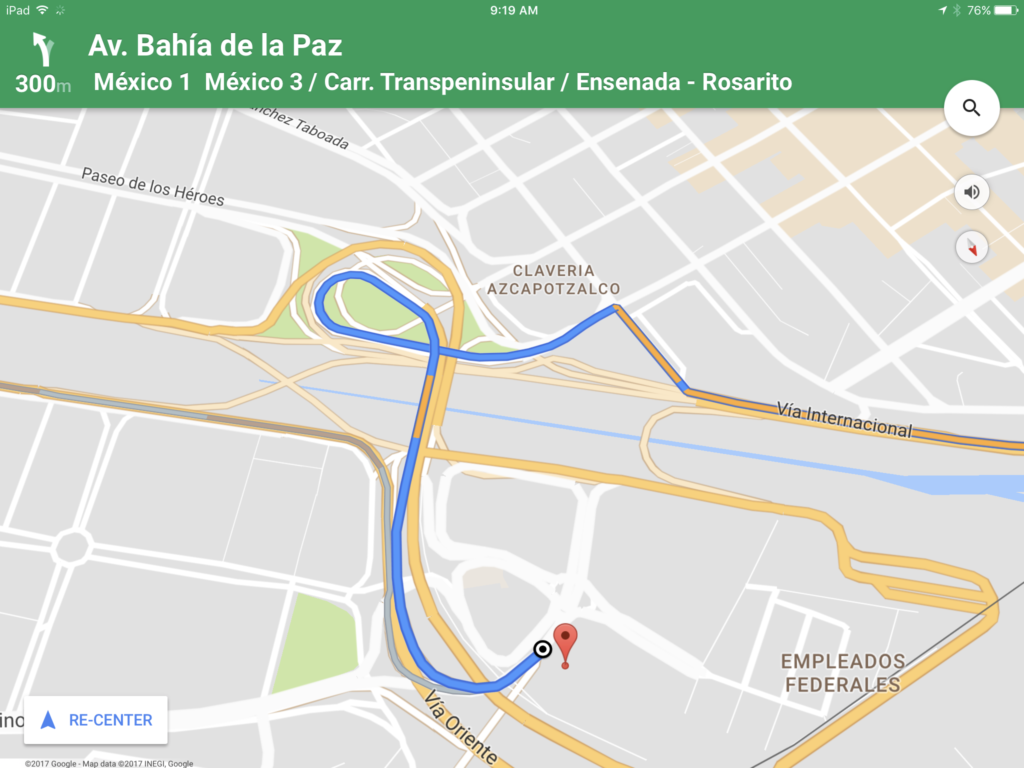
Trying to drive to a parking lot near the San Ysidro border crossing; we never made it and finally took a taxi. Do you see that circle in the route? Well, we you approach that circle, there are five separate forks to choose from. We could never get on the correct one!
The good news is that from then on, the ordeal of getting across the border to get cash and back to Ensenada went smoothly. The van driver was right – we got to the front of the line and were across in maybe 15 minutes max. Wells Fargo was a short walk from the border crossing, and the withdrawal was as easy as showing my debit card to the teller and knowing my pin. After Mexico, I forgot how easy banking can be in the States. Even with a stop at McDonalds, we were in the US for no more than a half hour. Re-entering Mexico was even easier; there was no waiting, and we were even told after taking the “foreigner” line that we can now take the “Mexican” line in future entries because we have temporary resident cards. We hopped into a taxi to take us back to Costco, where a gentleman hinted for a tip because he claimed he had been watching over our car, and we gratefully obliged.
Back in Ensenada, we went directly to S.O.S., paid for our life raft, got the paperwork including the certification, picked up the raft and were off. We arrived back at our cabin at about the same hour as we has arrived the day before. We were sad to have lost six hours of our vacation on an ordeal that should have been unnecessary, but we were grateful the ordeal was finished and we had what we came for: a recertified liferaft.
While having a well-deserved California wine on our deck for another sunset, a woman from the neighboring cabin appeared with a bottle of warm rosé in her hand, the corkscrew well into the cork, asking for help. It was the kind of corkscrew with a lever used to pry out the cork by leveraging it against the bottle lip. She could tell we were experts! Rick had the cork out for her in a matter of seconds. I then reminded her that rosé was best served cold. Rick and I sat longer on the deck well into the evening and had some discussions that mattered, and then retired for the night.
On the drive back to La Paz, we decided to take two nights instead of one so the driving would be easier. The fist night we stopped in a hotel that was designed to look like a hacienda, in a town called Cataviña. At first glance, it was a beautiful hotel: large, roomy and almost, but not quite, elegant. But it was all form and no substance, like a house of cards. Unfortunately, although currently in private hands, it was still run like the government-owned hotel it had once been. The rooms were arranged around a large garden area with a pool and hot tub, but they were cold and full of leaves. The management actually had the nerve to charge $1.50 U.S. per hour for internet! Rick said his hamburger in their restaurant was the worst he had ever eaten, and the whole shrimp somehow stuffed into an my half-avocado salad were warm. However, we did manage to enjoy a fun game of pool in the ample bar room. The only other customers were two groups of guys on motorcycles, one from the States on a dirt bike adventure, and the other, a group of Mexican men driving very very nice, large road bikes.
We had a bit of a catastrophe on the stretch of road from Cataviña back to Guerrero Negro. Rick had done most of the driving and had started to become complacent about the potholes, which was easy to do: much of the road earlier in the trip was in great shape, we had accepted already that the road was going to occasionally be hard on the car, and while the road had gradually been getting worse, the potholes were not yet that frequent to alert us to the need to slow down dramatically. And then, boom! we hit what seemed like the mother of all potholes. Rick said he didn’t see it. He didn’t slow down significantly; I guess he figured it was an isolated incident. Then, boom! another big pothole. On the third boom!, the car slumped to the right and we could hear the tire flapping around. We slowed way down but continued driving, both because there was no shoulder to pull off on, and because Rick saw some kind of civilization ahead.
Aa we finally found a place to pull off, into a big gravel clearing with some abandoned structures and a guy selling bootleg gasoline out of barrels in his truck, we heard an alarm emitting from the car: it was telling us that a tire was loosing pressure. Not only had the right front tire blown out in two places, but it’s rim was also bent. The left front tire was flat as well, with accompanying damaged rim.
Obviously we only had one spare and two flats so we needed help. The guy who was selling gasoline took both of our flats and dented rims and returned a half hour later with the rims pounded out, the one good tire back on the rim, and another, used tire placed on the other rim to use as a spare. All for less than $100 U.S. What luck. We haven’t turned in the car yet so we don’t know how much we will get hit up for the tire problems, but hopefully our credit card insurance benefit will reimburse us as some point for whatever the cost is.
Driving more slowly and carefully after that, it was a welcome site when we crossed into the state of Baja California Sur, who maintains their roads much better. It was even more of a welcome sight when we came over the hill and saw the Sea of Cortez glimmering back at us.
We decided to get a room in Mulegé because it is supposed to be a cute town, but one that we most likely wouldn’t see from our boat because there is no anchorage there. The town itself deserved a drive through, but the hotel we liked best was actually on the other side of the river from the town. Mulegé is on a river but the river is not developed at all, possibly because it is known to flood. The hotel we stayed in, Hotel Serenidad, seemed like an iconic hotel from the past, with an owner, Don Johnson, who was apparently quite the legend in Mulegé. Don, in his 90’s, introducted himself to me and raved about living in Mexico for the last 50 years, obviously content with his life and the hotel he owned. The staff was friendly and helpful. And if you had an airplane, there was a landing strip right next to the hotel! We walked along the river, accesible from the hotel, and enjoyed watching the fishermen unload their nets from the shoreline at the mouth of the river.
After Mulegé, we slowly ventured down the Bahia Concepción coastline, checking out the anchorages we hoped to visit later this month. One had a hot springs built up into the shoreline – we definitely want to get back to that place in our boat!
It was nice to get back to Cool Change. We are not looking forward to turning the car back in, but we are anxious to get ourselves out of the marina and back out onto anchorages again. The Sea beckons!

